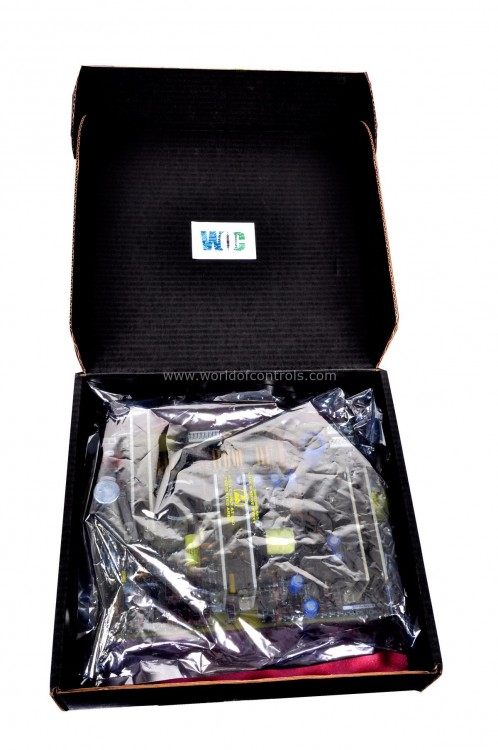SPECIFICATIONS
Part Number: DS200IAXSG1AAA
Manufacturer: General Electric
Series: Drive Control
Product Type: Inverter Snubber Board
Temperature 0 to 60oC (32 to 149 oF)
Availability: In Stock
Country of Manufacturer: United States (USA)
Functional Description
DS200IAXSG1AAA is a Inverter Snubber Board developed by General Electric. It is a part of Drive Control system. The function of the IAXS board is to provide dv/dt suppression for the IGBT modules. This suppression mechanism effectively limits the rate of change of voltage (dv/dt) across the IGBTs during turn-on and turn-off events. By mitigating voltage transients, the snubber board ensures that the IGBTs operate within their specified voltage limits, safeguarding them against potential damage or degradation.
Features
- Voltage Transient Limitation: The IAXS board meticulously controls voltage transients across the IGBTs across various operating conditions of the drive. Whether during startup, shutdown, or steady-state operation, the snubber board maintains voltage transients within safe thresholds, thereby preserving the integrity and reliability of the IGBT modules over the entire operational spectrum.
- Gate Driver Signal Conditioning: In addition to dv/dt suppression, the snubber board also provides gate driver signal conditioning. This feature optimizes the signals sent to the IGBTs' gate drivers, ensuring precise and reliable switching operations. By conditioning the gate signals, the IAXS board enhances the efficiency and accuracy of the IGBTs' switching actions, contributing to overall system performance and stability.
- Overvoltage Protection: Another critical function of the board is to offer overvoltage protection for the IGBTs. In the event of voltage spikes or surges beyond safe levels, the snubber board promptly detects and mitigates these overvoltages, preventing potential damage to the IGBT modules. This protective feature reinforces the robustness and longevity of the IGBTs, enhancing the overall reliability of the drive system.
Stab Connectors
- DCPL1 and DCPL2 Connectors: DCPL1 and DCPL2 connectors establish essential connections between the IAXS board and the DS200IMCP IMCP board. These connections play a pivotal role in transmitting control signals, power, and data between the two boards, facilitating coordinated operation and control of the IGBT modules.
The signals carried by these connectors are critical for the precise control and monitoring of the IGBT modules' performance, ensuring optimal operation and protection against faults or abnormalities.
DCPLF1 and DCPLF2 Connectors: DCPLF1 and DCPLF2 connectors serve similar functions to DCPL1 and DCPL2 connectors but are specifically dedicated to facilitating the transmission of feedback signals and data related to the IGBT modules' performance.
These connectors enable the exchange of vital information such as current, voltage, temperature, and status feedback between the IAXS board and the IMCP board. This feedback loop is essential for real-time monitoring and control of the IGBT modules, allowing for rapid response to dynamic operating conditions and ensuring system reliability.
Plug-in Connectors
- APL Connector: The APL connector on the board establishes a vital interface with connector APL on the IIBD board. This connection serves as a conduit for transmitting essential control signals, power, and data between the two boards.
Through the APL connector, crucial commands and instructions are relayed from the board to the IIBD board, governing the operation and switching behavior of the IGBT modules. This includes signals for gate control, timing, and synchronization, ensuring precise and coordinated operation of the power electronics system.
- BPL Connector: Similarly, the BPL connector on the board interfaces with connector BPL on the IIBD, forming another critical link in the communication chain between the two components.
The BPL connection facilitates the exchange of additional control signals and data necessary for comprehensive control and monitoring of the IGBT modules. This may include signals related to temperature sensing, fault detection, and diagnostic feedback, enhancing system reliability and performance.
- CPL Connector: The CPL connector on the board interfaces with connector CPL on the IIBD, completing the triad of connections between the two components.
Through the CPL connection, essential feedback signals and status information are transmitted from the IIBD board to the board. This feedback loop enables real-time monitoring of the IGBT modules' performance, allowing for rapid response to changing operating conditions and ensuring optimal system operation and protection.
WOC has the largest stock of Speedtronic control spares. Please contact our staff by phone or email for pricing and availability on any parts and repairs
FREQUENTLY ASKED QUESTIONS
What is DS200IAXSG1AAA?
It is an inverter snubber board developed by General Electrics.
What signals are transmitted through the APL, BPL, and CPL connectors?
The APL, BPL, and CPL connectors facilitate the transmission of various control signals, power, and data between the IAXS board and the IIBD board. These signals include gate control signals, timing signals, temperature sensing signals, fault detection signals, and diagnostic feedback, among others.
How do these connections contribute to the overall performance and reliability of the power electronics system?
By establishing robust connections between the IAXS and the IIBD, precise control, monitoring, and protection of the IGBT modules are ensured. This contributes to the overall efficiency, reliability, and safety of the power electronics system by enabling coordinated operation and rapid response to changing operating conditions.
What happens if there is a failure or disruption in the communication between the IAXS and the IIBD?
In the event of a failure or disruption in communication, the system may experience operational issues or malfunctions. Therefore, it's crucial to ensure the integrity and reliability of the connections between the two boards to maintain optimal system performance and functionality.
